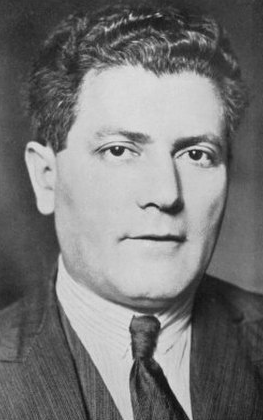Nandor Fodor facts for kids
Quick facts for kids
Nandor Fodor
|
|
|---|---|
 |
|
| Born |
Nandor Friedlander
13 May 1895 Berehove, Austria-Hungary, now Ukraine
|
| Died | 17 May 1964 (aged 69) |
| Occupation | Parapsychologist Psychoanalyst |
| Organization | National Laboratory of Psychical Research Society for Psychical Research The Ghost Club |
Nandor Fodor (born May 13, 1895 – died May 17, 1964) was a smart writer, journalist, and expert in two interesting fields: parapsychology and psychoanalysis. He was originally from Hungary, but he worked in both Britain and America.
Contents
Discovering Nandor Fodor's Life
Nandor Fodor was born in Beregszász, which was part of the Austro-Hungarian Empire. Today, this place is called Berehove and is in Ukraine. He came from a Jewish family.
He studied law at the Royal Hungarian University of Science in Budapest, earning a special degree. Later, he moved to New York to work as a journalist. In 1929, he moved to Britain and continued his work for a newspaper company.
Fodor's Work in the Paranormal World
Fodor became a leading expert on poltergeists, hauntings, and other strange events. These events are often linked to mediumship, where people claim to talk to spirits.
He even worked with Sigmund Freud for a time. Freud was a very famous doctor who studied the human mind. Fodor wrote about how babies develop before birth and how to understand dreams. His most famous work is the Encyclopedia of Psychic Science, first published in 1934. This book is like a huge dictionary of psychic topics.
From 1935 to 1939, Fodor was the London reporter for the American Society for Psychical Research. He also helped edit the Psychoanalytic Review magazine. He was also a member of the New York Academy of Sciences.
Changing Views on Psychic Phenomena
In the 1930s, Fodor believed in many paranormal things. But by the 1940s, his ideas started to change. He began to look at psychic events using a psychoanalytic approach. This means he tried to understand them through the human mind and emotions.
He wrote newspaper articles that questioned whether mediums were real. This made some spiritualists, who strongly believed in mediums, quite upset with him.
One of the strange cases he studied was Gef the talking mongoose. This unusual story even inspired a movie in 2023 called Nandor Fodor and the Talking Mongoose.
Understanding Poltergeists with Fodor
Nandor Fodor had a new idea about poltergeists. He thought they were not separate ghosts with their own minds. Instead, he believed they were signs of problems hidden deep inside a person's subconscious mind.
He suggested that poltergeist events happen when people are very stressed or upset. He compared these disturbances to physical symptoms that can appear when someone is under a lot of emotional tension.
Investigating the Thornton Heath Poltergeist
In 1938, Fodor looked into a famous poltergeist case in Thornton Heath. It involved a woman named Mrs. Forbes. Fodor believed that Mrs. Forbes's own mind was causing the strange events. He thought she had a mental disturbance.
He found that a difficult experience from Mrs. Forbes's childhood, which she had forgotten, was causing the problems. Because Fodor was skeptical and thought the events were not real ghosts, many spiritualists were angry. He was even fired from his job at the International Institute for Psychical Research. The founder of the institute, Arthur Findlay, disagreed with Fodor's research and quit. Fodor was attacked in a spiritualist newspaper called Psychic News. He then sued the newspaper for libel, which means saying false things that harm someone's reputation.
Fodor's Books on Poltergeists
Fodor wrote two important scientific papers about poltergeists. These were The Psychoanalytic Approach to the Problems of Occultism (1945) and The Poltergeist, Psychoanalyzed (1948). He famously said, "The poltergeist is not a ghost. It is a bundle of projected repressions." This means he thought poltergeists were like hidden emotional problems coming out.
He also wrote a book with another researcher, Hereward Carrington, called Haunted People: Story of the Poltergeist down the Centuries (1951). This book was well-liked by many.
Some experts, like psychologist Robert Baker and investigator Joe Nickell, praised Fodor's book The Haunted Mind. They said Fodor often found that "ghosts" were actually made up by the subconscious mind of the person experiencing them. However, Fodor also believed that some poltergeist events might be explained by psychokinesis. This is the idea that the mind can move objects. This idea has been criticized by some. For example, the magician Henry Gordon thought Fodor and other parapsychologists were too quick to believe in paranormal explanations instead of looking for simple tricks or deception.
Exploring Prenatal Psychology
Nandor Fodor's book The Search for the Beloved (1949) was very important in the field of prenatal psychology. This field studies how experiences before birth can affect a person.
Fodor believed that a pregnant mother could communicate with her unborn baby using telepathy, which is like mind-to-mind communication. He thought that a mother's feelings and thoughts could even cause physical or mental events in her unborn child. However, some science writers, like Martin Gardner, said in 1957 that Fodor's ideas about telepathy were pseudoscience. This means they were not based on real scientific evidence.

